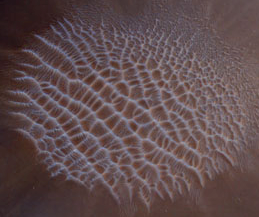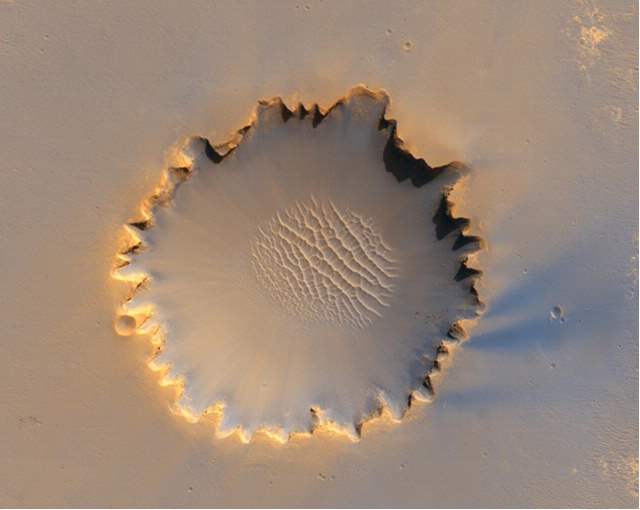https://youtu.be/Bv7hAah1zhk
Consider the dune pattern at the base of this impact crater on Mars
https://youtu.be/Bv7hAah1zhk
Consider the dune pattern at the base of this impact crater on Mars
dv said:
https://youtu.be/Bv7hAah1zhkConsider the dune pattern at the base of this impact crater on Mars
very neat. swirling air due to the crater sides causing it? any similar patterns on earth?
Web-like dune patterns are quite common in Martian craters. Here’s Santa Maria crater visited by Opportunity.
Victoria crater, also explored by Opportunity, seen here from space.

Bubblecar said:
Victoria crater, also explored by Opportunity, seen here from space.
It…….gulp……..it looks like a virus.
Bubblecar said:
Victoria crater, also explored by Opportunity, seen here from space.
These appear to have been created by the sides falling in and very little wind/water influence?
roughbarked said:
Bubblecar said:
Victoria crater, also explored by Opportunity, seen here from space.
These appear to have been created by the sides falling in and very little wind/water influence?
Wind patterns within the crater, most likely.
Bubblecar said:
roughbarked said:
Bubblecar said:
Victoria crater, also explored by Opportunity, seen here from space.
These appear to have been created by the sides falling in and very little wind/water influence?
Wind patterns within the crater, most likely.
Yes.
Bubblecar said:
Victoria crater, also explored by Opportunity, seen here from space.

Ooh ahh. I deserve censure for not noticing that earlier.
The main dune alignment is linear, top left to bottom right, like linear dune fields (eg Simpson desert) on Earth. The cross-hatching is not continuous, and not as high.
That sort of makes it intermediate between linear dunes and Barchan dunes. Or a result of having the wind from two different primary directions.
I’m uncertain as to whether these would occur on an open plain or not.
They are described in one article as “decameter-scale, sinuous-crested, eolian sand dunes migrating approximately perpendicular to the face of the outcrop”.
mollwollfumble said:
Bubblecar said:
Victoria crater, also explored by Opportunity, seen here from space.
Ooh ahh. I deserve censure for not noticing that earlier.
The main dune alignment is linear, top left to bottom right, like linear dune fields (eg Simpson desert) on Earth. The cross-hatching is not continuous, and not as high.
That sort of makes it intermediate between linear dunes and Barchan dunes. Or a result of having the wind from two different primary directions.
I’m uncertain as to whether these would occur on an open plain or not.
They are described in one article as “decameter-scale, sinuous-crested, eolian sand dunes migrating approximately perpendicular to the face of the outcrop”.
That is the kind of thing I was trying to wrap my brain around. Thanks.
mollwollfumble said:
Bubblecar said:
Victoria crater, also explored by Opportunity, seen here from space.
Ooh ahh. I deserve censure for not noticing that earlier.
The main dune alignment is linear, top left to bottom right, like linear dune fields (eg Simpson desert) on Earth. The cross-hatching is not continuous, and not as high.
That sort of makes it intermediate between linear dunes and Barchan dunes. Or a result of having the wind from two different primary directions.
I’m uncertain as to whether these would occur on an open plain or not.
They are described in one article as “decameter-scale, sinuous-crested, eolian sand dunes migrating approximately perpendicular to the face of the outcrop”.
roughbarked said:
mollwollfumble said:
Bubblecar said:
Victoria crater, also explored by Opportunity, seen here from space.
Ooh ahh. I deserve censure for not noticing that earlier.
The main dune alignment is linear, top left to bottom right, like linear dune fields (eg Simpson desert) on Earth. The cross-hatching is not continuous, and not as high.
That sort of makes it intermediate between linear dunes and Barchan dunes. Or a result of having the wind from two different primary directions.
I’m uncertain as to whether these would occur on an open plain or not.
They are described in one article as “decameter-scale, sinuous-crested, eolian sand dunes migrating approximately perpendicular to the face of the outcrop”.
That is the kind of thing I was trying to wrap my brain around. Thanks.
Possibly a characteristic of dunes everywhere
Cymek said:
roughbarked said:
mollwollfumble said:
Ooh ahh. I deserve censure for not noticing that earlier.
The main dune alignment is linear, top left to bottom right, like linear dune fields (eg Simpson desert) on Earth. The cross-hatching is not continuous, and not as high.
That sort of makes it intermediate between linear dunes and Barchan dunes. Or a result of having the wind from two different primary directions.
I’m uncertain as to whether these would occur on an open plain or not.
They are described in one article as “decameter-scale, sinuous-crested, eolian sand dunes migrating approximately perpendicular to the face of the outcrop”.
That is the kind of thing I was trying to wrap my brain around. Thanks.
Possibly a characteristic of dunes everywhere
When I was flying around the Middle East, I used to find the shapes & sizes of the sand dunes fascinating. They’d vary greatly from long smooth hills to shorter sharper types and everything in between.
It does look a bit like transverse dunes we get on Earth but I have to say I’ve not seen anything quite like that here.
dv said:
It does look a bit like transverse dunes we get on Earth but I have to say I’ve not seen anything quite like that here.
The crater slopes would create some interesting wind movements that you would not get in a flatter environment.
PermeateFree said:
dv said:
It does look a bit like transverse dunes we get on Earth but I have to say I’ve not seen anything quite like that here.
The crater slopes would create some interesting wind movements that you would not get in a flatter environment.
Yes.
roughbarked said:
PermeateFree said:
dv said:
It does look a bit like transverse dunes we get on Earth but I have to say I’ve not seen anything quite like that here.
The crater slopes would create some interesting wind movements that you would not get in a flatter environment.
Yes.
I wonder how’d they match to some of craters on Earth that contain sand
Cymek said:
roughbarked said:
PermeateFree said:The crater slopes would create some interesting wind movements that you would not get in a flatter environment.
Yes.
I wonder how’d they match to some of craters on Earth that contain sand
I’d say that there are different factors.  is Wolf Creek.
is Wolf Creek.
roughbarked said:
Cymek said:
roughbarked said:Yes.
I wonder how’d they match to some of craters on Earth that contain sand
I’d say that there are different factors.
is Wolf Creek.

Roter Kamm, South West Africa/Namibia
This one looks psychadelic. 
2. Isidorus D, Lunar Highlands
Diameter: 15 km
This oblique view looking north, taken with the panoramic camera on Apollo 16, shows a typical, simple bowl-shaped crater on the Moon. Evidence of avalanching and slope collapse are clearly visible on the inner walls of the crater. Streaks on the left wall appear to be avalanche scars; along the southeast part of the crater wall, many short irregular benches or narrow terraces mark the tops of slump blocks. The sharp break in slope, marking the rim crest, is clearly visible along the southeast portion of the structure. On Earth, the transition from simple craters to complex craters occurs at smaller diameters than on the Moon because of Earth’s higher gravity. (Apollo lunar photograph AS16-4502(P).)

roughbarked said:
roughbarked said:
Cymek said:I wonder how’d they match to some of craters on Earth that contain sand
I’d say that there are different factors.
is Wolf Creek.

Roter Kamm, South West Africa/Namibia
Those craters look fresh Watson.
Peak Warming Man said:
roughbarked said:
roughbarked said:I’d say that there are different factors.
is Wolf Creek.

Roter Kamm, South West Africa/Namibia
Those craters look fresh Watson.
OK let’s move to Yuty, Northern Hemisphere, Mars.

Peak Warming Man said:
roughbarked said:
roughbarked said:I’d say that there are different factors.
is Wolf Creek.

Roter Kamm, South West Africa/Namibia
Those craters look fresh Watson.
The problem is the crater floor is quickly colonised by vegetation thereby stopping any complex dune formation, which of course does not happen on Mars.
PermeateFree said:
Peak Warming Man said:
roughbarked said:

Roter Kamm, South West Africa/Namibia
Those craters look fresh Watson.
The problem is the crater floor is quickly colonised by vegetation thereby stopping any complex dune formation, which of course does not happen on Mars.
Yes my dear Sherlock. :)
I do think there are various other factors but in difference to earth that would be the first one.
Cymek said:
roughbarked said:
PermeateFree said:The crater slopes would create some interesting wind movements that you would not get in a flatter environment.
Yes.
I wonder how’d they match to some of craters on Earth that contain sand
Not that I saw at Wolfe Creek and Henbury.
Michael V said:
Cymek said:
roughbarked said:Yes.
I wonder how’d they match to some of craters on Earth that contain sand
Not that I saw at Wolfe Creek and Henbury.
That’s why indeed I was rolling out the photos. It appears thta it doesn’t matter whether the craters are on earth moon or mars. These dune patterns are otherwise rather unique for some reason or others.
roughbarked said:
Michael V said:
Cymek said:I wonder how’d they match to some of craters on Earth that contain sand
Not that I saw at Wolfe Creek and Henbury.
That’s why indeed I was rolling out the photos. It appears thta it doesn’t matter whether the craters are on earth moon or mars. These dune patterns are otherwise rather unique for some reason or others.
roughbarked said:
roughbarked said:
Michael V said:Not that I saw at Wolfe Creek and Henbury.
That’s why indeed I was rolling out the photos. It appears thta it doesn’t matter whether the craters are on earth moon or mars. These dune patterns are otherwise rather unique for some reason or others.

The curving ridges at the bottom are less than a meter high.
roughbarked said:
roughbarked said:
roughbarked said:That’s why indeed I was rolling out the photos. It appears thta it doesn’t matter whether the craters are on earth moon or mars. These dune patterns are otherwise rather unique for some reason or others.
The curving ridges at the bottom are less than a meter high.
Nice
Actually almost looks like some great artist created this place to be observed with awe.

roughbarked said:
Actually almost looks like some great artist created this place to be observed with awe.
I went to an astronomy lecture once where the speaker had photoshopped the Tidbinbilla deep space antennas into this crater. Nobody noticed. I didn’t notice.